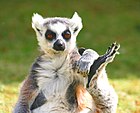Gunnison grouse
| Gunnison sage-grouse | |
|---|---|

| |
| Scientific classification | |
| Domain: | Eukaryota |
| Kingdom: | Animalia |
| Phylum: | Chordata |
| Class: | Aves |
| Order: | Galliformes |
| Family: | Phasianidae |
| Genus: | Centrocercus |
| Species: | C. minimus
|
| Binomial name | |
| Centrocercus minimus Young, Braun, C, Oyler-McCance, Hupp & Quinn, 2000[4]
| |

| |
| Gunnison sage-grouse range[5][6] | |
The Gunnison grouse, Gunnison sage-grouse or lesser sage-grouse (Centrocercus minimus) is a species of
Breeding
Gunnison sage-grouse are notable for their elaborate courtship rituals. Each spring, males congregate on
Conservation
This species is in decline because of
Distribution
Gunnison sage-grouse occur in seven counties in southwestern Colorado and one county in southeastern Utah. It was once found in
Life cycle
Males gather on the lek or strutting grounds, which are small, open areas where breeding occurs, in late February to April, as soon as the lek is relatively free of snow. Only a few dominant males, usually two, breed. After mating, the hen leaves the lek for the nesting grounds. Clutch size ranges from six to eight eggs; incubation time is 25 to 27 days. Sage-grouse apparently have high rates of nest desertion and nest predation. Chicks are precocial and can feed themselves. [11]
Preferred habitat
Gunnison sage-grouse are totally dependent on sagebrush-dominated habitats. Sagebrush is a crucial component of the adult's diet year-round, and they select sagebrush almost exclusively for cover. However, in order to rear a brood of chicks, the young require high protein broadleaved plants and wildflowers that bring insects, also for protein. However, cattle and sheep also relish these plants, and the removal of these critical chick-food plants is a major reason for this bird's decline.
References
![]() This article incorporates public domain material from Centrocercus minimus. United States Department of Agriculture.
This article incorporates public domain material from Centrocercus minimus. United States Department of Agriculture.
- . Retrieved 13 November 2021.
- ^ a b "Gunnison sage-grouse (Centrocercus minimus)". Environmental Conservation Online System. U.S. Fish & Wildlife Service. Retrieved 27 April 2023.
- ^ a b 79 FR 69192
- ^ "Centrocercus minimus Young, C. Braun, Oyler-McCance, Hupp & Quinn, 2000". Integrated Taxonomic Information System. Retrieved 27 April 2023.
- ^ BirdLife International and NatureServe (2014) Bird Species Distribution Maps of the World. 2012. Centrocercus minimus. In: IUCN 2014. The IUCN Red List of Threatened Species. Version 2014.3. http://www.iucnredlist.org. Downloaded on 30 May 2015.
- ^ National Geophysical Data Center, 1999. Global Land One-kilometer Base Elevation (GLOBE) v.1. Hastings, D. and P.K. Dunbar. National Geophysical Data Center, NOAA. doi:10.7289/V52R3PMS [access date: 2015-03-16].
- S2CID 20131406.
- JSTOR 4089344.
- ^ "Gunnison Sage-grouse". Western State Colorado University. Archived from the original on 23 October 2013.
- ^ "Colorado's Gunnison Sage-grouse Populations Plummet to Perilous Lows". Center for Biological Diversity. Retrieved 2019-10-23.
- ISBN 0803208103.



